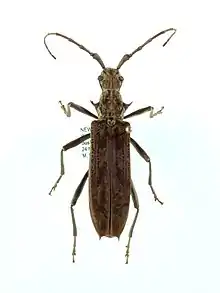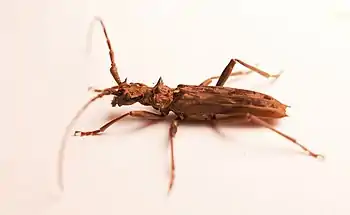Blosyropus spinosus
Blosyropus spinosus, also known as the spiny longhorn or spiny silver-pine borer, is a rare species of longhorn beetle endemic to New Zealand.[1][2] Its Māori names include howaka and kapapa.[3]
| Blosyropus spinosus | |
|---|---|
 | |
| Dorsal view of a Blosyropus spinosus specimen in the Whanganui Regional Museum | |
| Scientific classification | |
| Kingdom: | |
| Phylum: | |
| Class: | |
| Order: | |
| Suborder: | |
| Superfamily: | |
| Family: | |
| Subfamily: | |
| Tribe: | |
| Genus: | Blosyropus |
| Species: | B. spinosus |
| Binomial name | |
| Blosyropus spinosus Redtenbacher, 1868 | |
Taxonomy
The genus Blosyropus is often referred to within the subfamily Lepturinae, but is now considered to be in the Cerambycinae[4][5] and the tribe Phlyctaenodini.[6]
Distribution and habitat
Blosyropus spinosus has been found in forest in many areas of New Zealand.[7] Its larvae have been discovered in rotting logs of a variety of trees including tawa, Dracophyllum, pōhutukawa, manoao (silver pine), and red beech, as well as in podocarp forest.[2][8] It is a Category I (indeterminate status) Threatened Species.[9]

Description
_AMNZ49737.jpg.webp)
Blosyropus spinosus is one of the largest endemic beetles in New Zealand,[10] growing to around 46mm long.[2] It is nocturnal,[7] and flightless.[2] The hing wings are shortened or completely reduced in both sexes in this genus.[6] Blosyropus spinosus is dark brown in colour with yellowish hairs on its body.[2] Its key distinguishing characteristic is the pair of spines on its head, one above each eye, and the four spines on the pronotum in front of the elytra.[8][2]
Behaviour
The adult beetle is attracted to lights.[2] Eggs are laid towards the top of the tree and the larva tunnel downwards as they feed on the rotting wood.[11] Pupation occurs in a large pupal chamber at the base of the tree.[11] This pupal chamber opens to the outside but is plugged with coarsely chewed wood that has not been digested by the larva.[11] After completing metamorphosis, the beetle may overwinter or hibernate within the pupal chamber.[11]
References
- "Blosyropus spinosus Redtenbacher, 1868". New Zealand Organisms Register. New Zealand Organisms Register. Archived from the original on 3 September 2017. Retrieved 3 September 2017.
- "The Conservation Requirements of New Zealand's Nationally Threatened Invertebrates" (PDF). Department of Conservation. Government of New Zealand. Retrieved 18 April 2016.
- Miller, David (1952). "The insect people of the Maori". The Journal of the Polynesian Society. 61 (1/2): 1–61. JSTOR 20703320.
- Duffy, BAJ (1963). A monograph of the immature stages of Australasian timber beetles (Cerambycidae). pp. 1–235.
- Sopow, Stephanie; Gresham, Belinda; Bain, John (2015). "Exotic longhorn beetles (Coleoptera: Cerambycidae) established in New Zealand". New Zealand Entomologist. 38 (2): 107–125. doi:10.1080/00779962.2014.993798. S2CID 86130081.
- Leschen, Richard A. B., Beutel, Rolf (2014). Coleoptera, beetles. Volume 3, Morphology and systematics (Phytophaga). Berlin. ISBN 9783110273700. OCLC 878076434.CS1 maint: uses authors parameter (link)
- "Beetle (Longhorn Spiny) Blosyropus spinosus". Taranaki Educational Resource: Research, Analysis and Information Network. Taranaki Educational Resource: Research, Analysis and Information Network. Retrieved 18 April 2016.
- Crowe, Andrew (2002). Which New Zealand Insect?. North Shore: Penguin. p. 44. ISBN 978-0-14-100636-9.
- McGuinness, Carl A. (2001). The conservation requirements of New Zealand's nationally threatened invertebrates. Wellington, New Zealand: Biodiversity Recovery Unit, Dept. of Conservation. ISBN 0478220480. OCLC 49672723.
- Marris, John (24 September 2007). "Beetles - What is a beetle?". Te Ara - the Encyclopedia of New Zealand. Retrieved 3 September 2017.
- Morgan, F. David (1960). "The Comparative Biologies of Certain New Zealand Cerambycidae". New Zealand Entomologist. 2 (5): 26–34. doi:10.1080/00779962.1960.9722791.
External links
| Wikispecies has information related to Blosyropus spinosus. |
| Wikimedia Commons has media related to Blosyropus spinosus. |